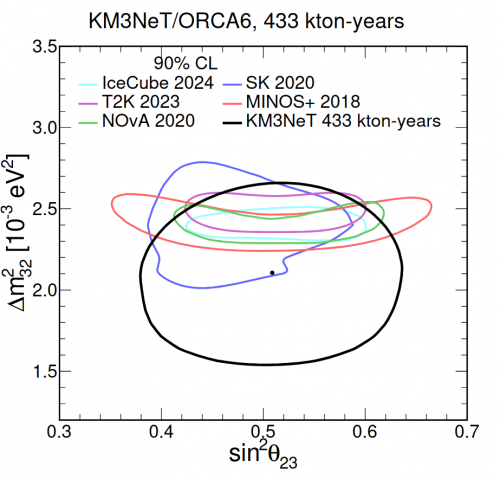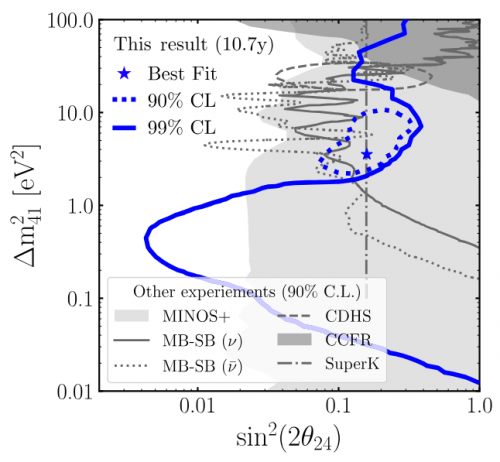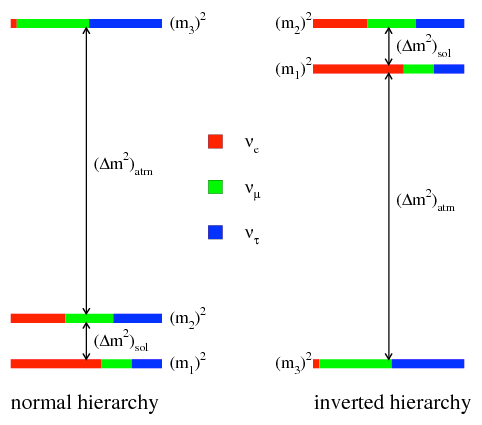Research

Particle and Neutrino Physics
Neutrino telescopes such as KM3NeT not only use neutrinos as a tool to study astrophysical objects and other physics phenomena such as dark matter, but can also help to investigate neutrino properties and look for possible extensions of the Standard Model of Particle Physics (SM).
The atmosphere is a copious source of neutrinos. These atmospheric neutrinos are in general a hindrance for astrophysical studies, but can provide very useful information about neutrinos themselves and the phenomenon of neutrino oscillations. In fact, atmospheric neutrinos played a key role in the discovery and understanding of this phenomenon.
Atmospheric neutrinos cover a very wide range of energies and baselines (distances from source to detector) and therefore have a great potential to observe possible deviations from their expected behaviour in the SM. Our research group is involved in the measurement of the parameters that describe standard neutrino oscillations and the search for phenomena predicted in a variety of scenarios which go beyond the Standard Model.
The atmosphere is a copious source of neutrinos. These atmospheric neutrinos are in general a hindrance for astrophysical studies, but can provide very useful information about neutrinos themselves and the phenomenon of neutrino oscillations. In fact, atmospheric neutrinos played a key role in the discovery and understanding of this phenomenon.
Atmospheric neutrinos cover a very wide range of energies and baselines (distances from source to detector) and therefore have a great potential to observe possible deviations from their expected behaviour in the SM. Our research group is involved in the measurement of the parameters that describe standard neutrino oscillations and the search for phenomena predicted in a variety of scenarios which go beyond the Standard Model.
KM3NeT has recently published the measurement of some key oscillation parameters with the ORCA6 detector, a configuration of KM3NeT/ORCA that contains six detector units[1]. Despite the small size of ORCA6 compared to its final configuration (5% of the full ORCA) and limited recording time (540 days) the results are already close to those of other experiments, as can be seen in the following figure, where the 90% CL contours for the parameters sin2θ23 and Δm232 from ORCA6 (in black) are shown together with those from other experiments:

New data with larger configurations of ORCA are readily available and we are presently studying them, so that our precision on these parameters will soon improve.
Some theories posit the existence of interactions not included in the SM. These “non-standard” neutrino interactions that could come from new physics at a higher energy scale would change the shape of the spectrum of atmospheric neutrinos. We have studied the possibility of such non-standard interactions with the ORCA6 detectors. The absence of evidence has enabled us to limit the size of the parameters that describe these interactions (εeμ, εeτ, εμμ, εττ and εμτ). The limits that we obtain[2] are of the order of the best current limits, as can be seen in the following figure:
Some theories posit the existence of interactions not included in the SM. These “non-standard” neutrino interactions that could come from new physics at a higher energy scale would change the shape of the spectrum of atmospheric neutrinos. We have studied the possibility of such non-standard interactions with the ORCA6 detectors. The absence of evidence has enabled us to limit the size of the parameters that describe these interactions (εeμ, εeτ, εμμ, εττ and εμτ). The limits that we obtain[2] are of the order of the best current limits, as can be seen in the following figure:

Quantum decoherence is the process by which a physical system’s behaviour changes from that which can be explained by quantum mechanics to classical physics and can stem from various sources, including quantum gravity effects. Quantum decoherence in the neutrino system will give rise to deviations from the standard oscillations.
Again using ORCA6 data we have been able to set limits on several possibilities of quantum decoherence[3], as can be seen in the following figure:
Again using ORCA6 data we have been able to set limits on several possibilities of quantum decoherence[3], as can be seen in the following figure:

Our group has also searched for light sterile neutrinos. Some anomalous results from three experiments (BEST, LSND, and MiniBooNE) could be explained with an additional sterile neutrino state with a mass of the order of one MeV. The IceCube detector has been able to set limits to that possibility, as can be seen in the following plot of the parameters that describe the oscillation to this new state[4]:

As this analysis indicated a mild preference (2.2σ) for a light sterile neutrino in the muon-neutrino disappearance channel, a member of our research team, who participated in the IceCube’s analysis, has continued it with the KM3NeT/ARCA detector. The analysis revealed that ARCA can set competitive limits before the end of this decade.
The ORCA detector of the KM3NeT experiment will be able to determine the neutrino mass ordering (NMO), that is, to disentangle between the two possible orderings of the neutrino mass states, i.e. normal (m1 < m2 < m3) or inverted (m3 < m1 < m2).
The ORCA detector of the KM3NeT experiment will be able to determine the neutrino mass ordering (NMO), that is, to disentangle between the two possible orderings of the neutrino mass states, i.e. normal (m1 < m2 < m3) or inverted (m3 < m1 < m2).

The determination of the NMO with atmospheric neutrinos is based on the observation of a net difference in the event rates, resulting from a larger interaction cross section and the existing atmospheric flux difference for neutrinos with respect to antineutrinos. Due to this event rate difference, the strength of the matter effects is larger for normal ordering (NO) compared to inverted ordering (IO).
Our group is involved in the study of the determination of NMO with the KM3NeT/ORCA detector.
Our group is involved in the study of the determination of NMO with the KM3NeT/ORCA detector.
[1] “Measurement of neutrino oscillation parameters with the first six detection units of KM3NeT/ORCA”, KM3NeT coll., Journal of High Energy Physics 2024, 206(2024). DOI:10.1007/JHEP10(2024)206 [arXiv:2408.07015]
[2] “Search for non-standard neutrino interactions with the first six detection units of KM3NeT/ORCA”, KM3NeT coll. [arXiv:2411.19078]
[3] “Search for quantum decoherence in neutrino oscillations with six detection units of KM3NeT/ORCA”, KM3NeT coll. [arXiv:2410.01388]
[4] “Search for an eV-Scale Sterile Neutrino Using Improved High-Energy 𝜈𝜇 Event Reconstruction in IceCube”, IceCube coll., Physical Review Letters 2024, 133(201804). DOI:10.1103/PhysRevLett.133.201804 [arXiv:2405.08070]
[2] “Search for non-standard neutrino interactions with the first six detection units of KM3NeT/ORCA”, KM3NeT coll. [arXiv:2411.19078]
[3] “Search for quantum decoherence in neutrino oscillations with six detection units of KM3NeT/ORCA”, KM3NeT coll. [arXiv:2410.01388]
[4] “Search for an eV-Scale Sterile Neutrino Using Improved High-Energy 𝜈𝜇 Event Reconstruction in IceCube”, IceCube coll., Physical Review Letters 2024, 133(201804). DOI:10.1103/PhysRevLett.133.201804 [arXiv:2405.08070]
